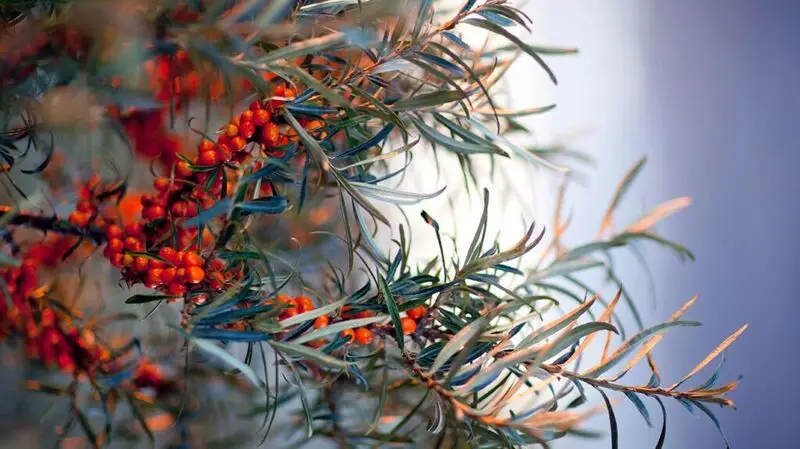
- According to a new study, sea buckthorn berries, which have been used as medicinal plants for centuries, contain powerful antioxidants.
- The findings showed encouraging signs for sea buckthorn berries for treating diabetes and obesity during in vitro tests.
- It’s possible the harsh coastal environments in which the shrub grows cause it to produce more antioxidants as a response to its own environmental stressors.
- Sea buckthorn joins a growing list of potent nutraceuticals whose long-held medicinal value is being confirmed by modern science.
A new study from Memorial University in Newfoundland, Canada, has identified what may be an antioxidant powerhouse in a shrub that grows in coastal areas in Newfoundland.
The study asserts the berries from the plant sea buckthorn have unique nutritional characteristics that have the potential to treat diabetes and obesity.
The findings were recently published in the
This is not the first time sea buckthorn berries have been identified as having significant value for human health. The berries are already popular in Asia and have also been used for treating arthritis and other inflammatory conditions in Europe.
Sea buckthorn berries contain powerful antioxidants that inhibit or prevent damage caused to the body’s cells by free radicals. (Free radicals are believed to be products of environmental and other stressors.)
The shrub’s berries and leaves have been widely used for supporting nutrition and have been used as pharmaceuticals.
Due to their Health properties, Canadian governmental agencies introduced sea buckthorn to the country in the early 2000s. Preliminary research at that time suggested the plant had vast commercial potential.
The plant’s oil is also a
According to Dr. Menka Gupta, a functional medicine doctor with Nutra Nourish, not involved in the study, sea buckthorn berries “have been used for centuries in traditional medicine in Tibet, China, and several other Asian and European countries.”
“The most documented use cases are for digestive health, stomach and intestinal problems, cardiovascular health, skin diseases, and ulcers,” Dr. Gupta told Medical News Today.
The authors of the present study report the promising findings of sea buckthorn berries for treating diabetes and obesity was observed in vitro.
Michelle Routhenstein, a registered dietitian and nutritionist at EntirelyNourished.com, not involved in the study, cited the vitamins C and E that sea buckthorn contains, as well as “flavonoids, carotenoids, and phenolic compounds, along with their dietary fiber content.”
“These may play a role in their potential effects on diabetes cells by reducing oxidative damage and inflammation, potentially improving insulin sensitivity and glucose metabolism,” Routhenstein explained.
Similarly, in combating obesity, these antioxidants and dietary fiber may help mitigate oxidative stress and inflammation, supporting metabolic health and aiding in weight management efforts.
“Due to its combination of anti-inflammatory and antimicrobial properties, [sea buckthorn] can have a positive influence on gut health. Better gut health has a positive impact on metabolic health, potentially helping manage diabetes and obesity.”
— Dr. Menka Gupta, functional medicine doctor
Discovering medicinal properties in plants is often a carryover from their traditional use before physicians’ experience of the plants’ benefits was supplanted by modern scientific studies.
Dr. Gupta listed a few common plant-based nutraceuticals as examples:
- turmeric
- ginger
- green tea
- blueberries
- chia seeds
- flax seeds
“They contain certain bioactive compounds which provide health benefits through various mechanisms such as antioxidant properties, anti-inflammatory effects and how they impact gut health.”
“They are also shown to improve immune function. Polyphenols found in mentioned foods can improve vascular health and reduce the risk of cardiovascular disease,” Dr. Gupta added.
Routhenstein cited several other modern nutraceuticals:
Resveratrol — found in black grapes, certain berries, and peanuts, has antioxidant properties that may benefit heart health by reducing inflammation, improving blood flow, and protecting against oxidative damage to blood vessels.Astaxanthin — a carotenoid pigment abundant in algae and seafood such as salmon and shrimp, has demonstrated anti-inflammatory, and vasodilatory effects.Lignans — from flaxseeds and sesame seeds have antioxidant properties that may help support heart health by reducing inflammation and oxidative stress.Plant sterols and stanols — naturally occurring in fruits, vegetables, nuts, and seeds, may help lower LDL cholesterol levels by inhibiting cholesterol absorption in the intestines, ultimately reducing circulating LDL cholesterol.
Sea buckthorn is a hardy, thorny, deciduous shrub, typically thriving along windswept coastlines.
There are numerous coastal plants with strong antioxidant properties, said Dr. Gupta, including cranberries, rosemary, and lavender.
Routhenstein cited several more: “The young leaves of Hibiscus tiliaceus, Syzigium corymbosa, Calophyllum inophyllum, and Colubrina asiatica — commonly known as beach hibiscus, water apple, Alexandrian laurel, and Asian snakewood respectively — have been shown to also provide antioxidant properties.”
Routhenstein and Dr. Gupta suspected coastal climates may have a unique ability to produce powerful antioxidants.
“I would think that the challenging conditions under which coastal plants grow, such as high-salt soil, variable moisture, and poor nutrient content, probably increases oxidative stress in these plants,” Dr. Gupta said.
“This leads to an adaptation response by these plants — leading to higher levels of antioxidant production,” Dr. Gupta said, from which we may benefit.
In any event, these are tough plants, and they are not exclusively found along coastlines, but also in other inhospitable environments.
“A few years ago, I was surprised to see Buckthorn berries growing wildly in Ladakh, India,” Dr. Gupta recalled, noting Ladakh is the highest plateau in the country. “[Sea buckthorn] is considered drought resistant and can withstand extreme temperatures,” she noted.





